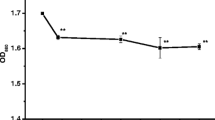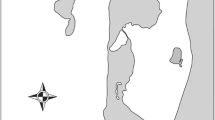Abstract
The knowledge of the effects of Sb(V) on the physiological characteristics of cyanobacteria was still limited. In the present study, responses of photosystem I and II (PSI and PSII), cyclic electron flow (CEF), and interphotosystem electron transport of Microcystis aeruginosa to 5–100 mg/l Sb(V) were synchronously measured using the Dual-PAM-100. 5 mg/l Sb (V) significantly inhibited PSII activity, but had no significant effects on PSI activity. At higher concentrations of Sb(V), the quantum yield and electron transport of PSI were less affected compared to PSII. The ratio of Y(II)/Y(I) significantly decreased with increasing Sb(V) concentration. It decreased from 0.7 for control to 0.4 for 100 mg/l Sb(V)-treated cells, indicating that the change of the distribution of quantum yields between two photosystems and more serious inhibition of PSII under stress of Sb(V) compared to PSI. CEF was activated associated with the inhibition of linear electron flow after exposure to Sb(V). The contribution of Y(CEF) to the quantum yield and activity of PSI increased with increasing Sb(V) concentrations. The cyclic electron transport rate made a significant contribution to electron transport rate of PSI, especially at high Sb(V) concentration (100 mg/l) and high illumination (above 555 μmol photons/m2/s). The stimulation of CEF was essential for the higher tolerance of PSI than PSII to Sb(V).




Similar content being viewed by others
References
Appenroth KJ, Stöckel J, Srivastava A, Strasser RJ (2001) Multiple effects of chromate on the photosynthetic apparatus of Spirodela polyrhiza as probed by OJIP chlorophyll a fluorescence measurements. Environ Pollut 115:49–64
Atal N, Saradhi PP, Mohanty P (1991) Inhibition of the chloroplast photochemical reactions by treatment of wheat seedlings with low concentrations of cadmium: analysis of electron transport activities and changes in fluorescence yield. Plant Cell Physiol 32:943–951
Bustamante J, Dock L, Vahter M, Fowler B, Orrenius S (1997) The semiconductor elements arsenic and indium induce apoptosis in rat thymocytes. Toxicology 118:129–136
Coopman RE, Fuentes-Neira FP, Briceño VF, Cabrera HM, Corcuera LJ, Bravo LA (2010) Light energy partitioning in photosystems I and II during development of Nothofagus nitida growing under different light environments in the Chilean evergreen temperate rain forest. Trees Struct Funct 24:247–259
Deng C, Zhang D, Pan X, Chang F, Wang S (2013) Toxic effects of mercury on PSI and PSII activities, membrane potential and transthylakoid proton gradient in Microsorium pteropus. J Photochem Photobiol B: Biol 127:1–7
Gao S, Wang G (2012) The enhancement of cyclic electron flow around photosystem I improves the recovery of severely desiccated Porphyra yezoensis (Bangiales, Rhodophyta). J Exp Bot 63:4349–4358
He M, Yang J (1999) Effects of different forms of antimony on rice during the period of germination and growth and antimony concentration in rice tissue. Sci Total Environ 243–244:149–155
He MC, Ji HB, Zhao CY, Xie J, Wu XM, Li ZF (2002) Preliminary studies of heavy metal pollution in soil and plant near antimony mine area. J Beijing Normal University (Nat Sci) 38:417–420
Huang W, Zhang S-B, Cao K-F (2010) Stimulation of cyclic electron flow during recovery after chilling-induced photoinhibition of PSII. Plant Cell Physiol 51:1922–1928
Huang W, Yang SJ, Zhang SB, Zhang JL, Cao KF (2012) Cyclic electron flow plays an important role in photoprotection for the resurrection plant Paraboea rufescens under drought stress. Planta 235:819–828
Johnson GN (2011) Physiology of PSI cyclic electron transport in higher plants. Biochim Biophys Acta 1807:384–389
Jones RD (1994) Survey of antimony workers: mortality 1961-1992. Occup Environ Med 51:772–776
Klughammer C, Schreiber U (1994) An improved method, using saturating light pulses, for the determination of photosystem I quantum yield via P700+-absorbance changes at 830 nm. Planta 192:261–268
Klughammer C, Schreiber U (2008) Complementary PS II quantum yields calculated from simple fluorescence parameters measured by PAM fluorometry and the Saturation Pulse method. PAM Appl Notes 1:27–35
Klughammer C, Schreiber U (2008) Saturation Pulse method for assessment of energy conversion in PS I. PAM Appl Notes 1:11–14
Kramer DM, Johnson G, Kiirats O, Edwards GE (2004) New fluorescence parameters for the determination of QA redox state and excitation energy fluxes. Photosynth Res 79:209–218
Kühl M, Glud RN, Borum J, Roberts R, Rysgaard S (2001) Photosynthetic performance of surface-associated algae below sea ice as measured with a pulse-amplitude-modulated (PAM) fluorometer and O2 microsensors. Mar Ecol Prog Ser 223:1–14
Munekage Y, Hashimoto M, Miyake C, Tomizawa KI, Endo T, Tasaka M, Shikanai T (2004) Cyclic electron flow around photosystem I is essential for photosynthesis. Nature 429:579–582
Nam S-H, Yang C-Y, An Y-J (2009) Effects of antimony on aquatic organisms (Larva and embryo of Oryzias latipes, Moina macrocopa, Simocephalus mixtus, and Pseudokirchneriella subcapitata). Chemosphere 75:889–893
Nitschke U, Connan S, Stengel DB (2012) Chlorophyll a fluorescence responses of temperate Phaeophyceae under submersion and emersion regimes: a comparison of rapid and steady-state light curves. Photosynth Res 114:29–42
Pan XL, Zhang D, Chen X, Bao AM, Li LH (2011) Antimony accumulation, growth performance, antioxidant defense system and photosynthesis of Zea mays in response to antimony pollution in soil. Water Air Soil Pollut 215:517–523
Pfündel E, Klughammer C, Schreiber U (2008) Monitoring the effects of reduced PS II antenna size on quantum yields of photosystems I and II using the Dual-PAM-100 measuring system. PAM Appl Notes 1:21–24
Platt T, Gallegos CL, Harrison WG (1980) Photoinhibition of photosynthesis in natural assemblages of marine phytoplankton. J Mar Res 38:687–701
Qian H, Tsuji T, Endo T, Sato F (2014) PGR5 and NDH pathways in photosynthetic cyclic electron transfer respond differently to sublethal treatment with photosystem-interfering Herbicides. J Agric Food Chem 62:4083–4089
Shikanai T (2007) Cyclic electron transport around photosystem I: genetic approaches. Annu Rev Plant Biol 58:199–217
Shtangeeva I, Bali R, Harris A (2011) Bioavailability and toxicity of antimony. J Geochem Explor 110:40–45
Siedlecka A, Krupa Z (1996) Interaction between cadmium and iron and its effects on photosynthetic capacity of primary leaves of Phaseolus vulgaris. Plant Physiol Biochem 34:833–841
Smichowski P (2008) Antimony in the environment as a global pollutant: a review on analytical method ologies for its determination in atmospheric aerosols. Talanta 75:2–14
Stanier RY, Kunisawa R, Mandel M, Cohen-Bazire G (1971) Purification and properties of unicellular blue-green algae (order Chroococcales). Bacteriol Rev 35:171–205
Sun FH, Wu FC, Liao HQ, Xing BS (2011) Biosorption of antimony(V) by freshwater cyanobacteria Microcystis biomass: chemical modification and biosorption mechanisms. Chem Eng J 171:1082–1090
Suzuki K, Ohmori Y, Ratel E (2011) High root temperature blocks both linear and cyclic electron transport in the dark during chilling of the leaves of rice seedlings. Plant Cell Physiol 52:1697–1707
Tschan M, Robinson B, Johnson CA, Bürgi A, Schulin R (2010) Antimony uptake and toxicity in sunflower and maize growing in SbIII and SbV contaminated soil. Plant Soil 334:235–245
Wang S, Pan X (2012) Effects of Sb(V) on growth and chlorophyll fluorescence of Microcystis aeruginosa (FACHB-905). Curr Microbiol 65:733–741
Wang S, Chen F, Mu S, Zhang D, Pan X, Lee D-J (2013) Simultaneous analysis of photosystem responses of Microcystis aeruginoga under chromium stress. Ecotoxicol Environ Saf 88:163–168
Zhang DY, Pan XL, Mu GJ, Wang JL (2010) Toxic effects of antimony on photosystem II of Synechocystis sp. as probed by in vivo chlorophyll fluorescence. J Appl Phycol 22:479–488
Zhou W, Juneau P, Qiu B (2006) Growth and photosynthetic responses of the bloom-forming cyanobacterium Microcystis aeruginosa to elevated levels of cadmium. Chemosphere 65:1738–1746
Acknowledgments
This work was supported by the National Natural Science Foundation of China (U1120302).
Author information
Authors and Affiliations
Corresponding author
Rights and permissions
About this article
Cite this article
Wang, S., Pan, X. & Zhang, D. PSI Showed Higher Tolerance to Sb(V) than PSII Due to Stimulation of Cyclic Electron Flow Around PSI. Curr Microbiol 70, 27–34 (2015). https://doi.org/10.1007/s00284-014-0678-5
Received:
Accepted:
Published:
Issue Date:
DOI: https://doi.org/10.1007/s00284-014-0678-5




